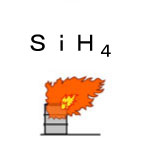| Case Name |
Fire in an exhaust air duct for silane gas |
| Pictograph |

|
| Date |
October 3, 1982 |
| Place |
Kiyotake, Miyazaki, Japan |
| Location |
Semiconductor factory |
| Overview |
This is the first domestic major accident in Japan from mono-silane making contact with air and causing a fire. Mono-silane is a special gas for a semiconductor. The most important factor was ignorance about its treatment. A lack of study on handling the substance and using raw materials was also an important cause, but it was said that because actions after the accident were not appropriate (delay in spraying water due to fear of equipment damage), the damage was aggravated. It seemed that there was insufficient study of countermeasures against a fire. |
| Incident |
Because of a malfunction at a silane gas flow control system of a plasma CVD unit, silane was supplied excessively, and more silane gas than usual was supplied to exhaust gas combustion devices, which were connected to the CVD unit. Then, a lot of unburned silane gas flowed into an exhaust duct. It reacted with air and ignited spontaneously. Moreover, as the duct was made of polypropylene, the fire spread along the duct. |
| Processing |
Consumption and usage |
| Substance |
Monosilane, Fig2 |
| Type of Accident |
Fire, environmental pollution |
| Sequence |
About 6:30 on October 3rd, 1982; an alarm for silane gas flow control equipment, which was one of the facilities in a plasma CVD unit, sounded.
About 6:30; an operator in charge closed a gas valve and repeated a holding operation three or four times, but the alarm continued to sound. He stopped the furnace.
About 8:20; he reported the trouble to the group head, and checked the holding operation and the valves. Soon, a fire broke out near the exhaust pipe of exhaust gas combustion equipment, and an exhaust duct, which was made of polypropylene, burned in the ceiling. |
| Cause |
Due to malfunctions of silane gas flow control devices and stopping of the oxygen gas supply, a large volume of unburnt silane flowed into the exhaust pipe. This silane reacted with air and ignited; then the polypropylene exhaust duct burned. The causes of the trouble with controlling the silane gas flow were considered that silane was oxidized in the piping and powder was generated. |
| Response |
The employees tried initial fire extinguishing, but failed. At 8:39, the public fire bridge was notified and turned out. As it took time to find the origin of the fire and in fear of the effects of spraying water and the possibility of electric shocks from high-voltage sources, spraying water was delayed. Because of the delay and a large quantity of smoke and poisonous gas, it was difficult to fight a fire. |
| Countermeasures |
Many mechanical improvements were made. |
| Knowledge Comment |
The evaluation in advance on handling new materials is important. |
| Background |
At the time, there was a general lack of knowledge on handling the substance, and there is a possibility that knowledge of the spontaneous ignition of silane was insufficient. There was also lack of consideration of materials, as the exhaust duct was made of polypropylene. Besides, problems with flow sensors of flow control devices often happened, but the root cause did not seem to be investigated, or appropriate measures were not taken. |
| Sequel |
A standard was instituted following this accident by High Pressure Gas Safety Inst. of Japan. Malfunctions of silane gas flow rate control devices seems to have happened often from the past. |
| Reason for Adding to DB |
Example of the first major domestic fire of special material gas in Japan |
| Scenario |
| Primary Scenario
|
Ignorance, Insufficient Knowledge, Insufficient Study, Poor Value Perception, Poor Safety Awareness, Inadequate Risk Recognition, Insufficient Analysis or Research, Insufficient Practice, Lack of Imagination, Planning and Design, Poor Planning, Poor Design, Bad Event, Chemical Phenomenon, Burning, Secondary Damage, External Damage, Fire, Bodily Harm, Death, Bodily Harm, Injury, 4 person injured, Loss to Organization, Economic Loss, Manetary Damage 3300 million yen
|
|
| Sources |
Shigeo Kondo. Ignition and explosion risk with special high-pressure gas. Research of disaster 25. pp.251-268(1994).
Toshihiro Hayashi. Examples of accidents in the semiconductor industry. Safety engineering. No.183. p.369 (1994).
Yoichi Uehara. Terushige Ogawa. Semiconductor accidents. Fire prevention and explosion-proof control technology handbook. pp.52-56 (1998)
|
| Number of Deaths |
1 |
| Number of Injuries |
4 |
| Physical Damage |
28.8 square meters of walls collapsed and 48 square meters of the first floor ceiling and a loft were destroyed by fire.
CVD equipment, combustion equipment, ion implantation equipment, a diffusion furnace, and other precision instruments were damaged. |
| Financial Cost |
¥ 3,300 million (Miyazaki City Fire fighting station) |
| Consequences |
2200 square meters damaged by smoke |
| Multimedia Files |
Fig2.Chemical_formula
|
| Field |
Chemicals and Plants
|
| Author |
WADA, Yuji (National Institute of Advanced Industrial Science and Technology)
TAMURA, Masamitsu (Center for Risk Management and Safety Sciences, Yokohama National University)
|
|